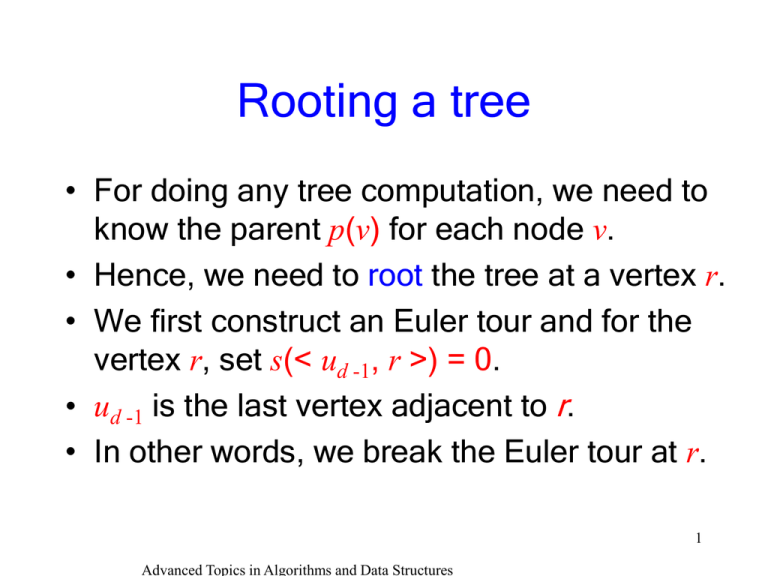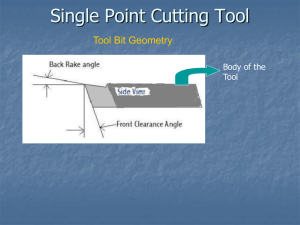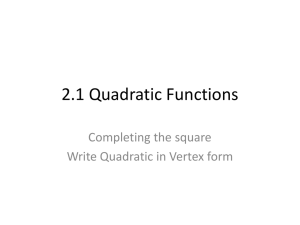Rooting a tree
advertisement

Rooting a tree • For doing any tree computation, we need to know the parent p(v) for each node v. • Hence, we need to root the tree at a vertex r. • We first construct an Euler tour and for the vertex r, set s(< ud -1, r >) = 0. • ud -1 is the last vertex adjacent to r. • In other words, we break the Euler tour at r. 1 Advanced Topics in Algorithms and Data Structures Rooting a tree 2 Advanced Topics in Algorithms and Data Structures Rooting a tree 3 Advanced Topics in Algorithms and Data Structures Rooting a tree Input: The Euler tour of a tree and a special vertex r. Output: For each vertex v r, the parent p(v) of v in the tree rooted at r. 4 Advanced Topics in Algorithms and Data Structures Rooting a tree begin 1. Set s(< u, r >) = 0, where u is the last vertex in the adjacency list of r. 2. Assign a weight 1 to each edge of the list and compute parallel prefix. 3. For each edge < x, y >, set x = p(y) whenever the prefix sum of < x, y > is smaller than the prefix sum of < y, x >. end 5 Advanced Topics in Algorithms and Data Structures Rooting a tree 6 Advanced Topics in Algorithms and Data Structures Computation of tree functions • Given a tree T, for many tree computations: – We first construct the Euler tour of T – Then we root the tree at a vertex • We can compute: – – – – – The postorder number of each vertex The preorder number of each vertex The inorder number of each vertex The level of each vertex The number of descendants of each vertex. 7 Advanced Topics in Algorithms and Data Structures Tree Contraction • Some tree computations cannot be solved efficiently with the Euler tour technique alone. • An important problem is evaluation of an arithmetic expression given as a binary tree. 8 Advanced Topics in Algorithms and Data Structures Tree Contraction • Each leaf holds a constant and each internal node holds an arithmetic operator like +,. • The goal is to compute the value of the expression at the root. • The tree contraction technique is a systematic way of shrinking a tree into a single vertex. • We successively apply the operation of merging a leaf with its parent or merging a degree-2 vertex with its parent. 9 Advanced Topics in Algorithms and Data Structures The RAKE operation • Let T = (V, E) be a rooted binary tree and for each vertex v, p(v) is its parent. • sib(v) is the child of p(v). We consider only binary trees. • In the rake operation for a leaf u such that p(u) r. – Remove u and p(u) from T, and – Connect sib(u) to p(p(u)). 10 Advanced Topics in Algorithms and Data Structures The RAKE operation • In our tree contraction algorithm, we apply the rake operation repeatedly to reduce the size of the binary tree. • We need to apply rake to many leaves in parallel in order to achieve a fast running time. 11 Advanced Topics in Algorithms and Data Structures The RAKE operation • But we cannot apply rake operation to nodes whose parents are consecutive on the tree. • For example, rake operation cannot be applied to nodes 1 and 8 in parallel. • We need to apply the rake operation to nonconsecutive leaves as they appear from left to right. 12 Advanced Topics in Algorithms and Data Structures The RAKE operation • We first label the leaves consecutively from left to right. • In an Euler path for a rooted tree, the leaves appear from left to right. • We can assign a weight 1 to each edge of the kind (v, p(v)) where v is a leaf. • We exclude the leftmost and the rightmost leaves. These two leaves will be the two children of the root when the tree is contracted to a three-node tree. • We do a prefix sum on the resulting list and the leaves are numbered from left to right. 13 Advanced Topics in Algorithms and Data Structures The RAKE operation • We now store all the n leaves in an array A. • Aodd is the subarray consisting of the oddindexed elements of A. • Aeven is the subarray consisting of the evenindexed elements of A. • We can create the arrays Aodd and Aeven in O(1) time and O(n) work. 14 Advanced Topics in Algorithms and Data Structures Tree contraction algorithm begin for log(n 1) iterations do 1. Apply the rake operation in parallel to all the elements of Aodd that are left children 2. Apply the rake operation in parallel to the rest of the elements in Aodd. 3. Set A := Aeven. end 15 Advanced Topics in Algorithms and Data Structures Tree contraction algorithm 16 Advanced Topics in Algorithms and Data Structures Correctness of tree contraction • Whenever the rake operation is applied in parallel to several leaves, the parents of any two such leaves are not adjacent. • The number of leaves reduces by half after each iteration of the loop. Hence the tree is contracted in O(log n) time. • Euler tour takes O(n) work. • The total number of operations for all the iterations of the loop is: n O( ( i )) O n 2 i 17 Advanced Topics in Algorithms and Data Structures











